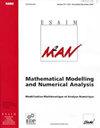求助PDF
{"title":"Infection spreading in cell culture as a reaction-diffusion wave","authors":"Mahiout Bessonov Nikolai Kazmierczak Bogdan Sadaka Georges Latifa Ait","doi":"10.1051/m2an/2022019","DOIUrl":null,"url":null,"abstract":"Infection spreading in cell culture occurs due to virus replication in infected cells and its random motion in the extracellular space. Multiplicity of infection experiments in cell cultures are conventionally used for the characterization of viral infection by the number of viral plaques and the rate of their growth. We describe this process with a delay reaction-diffusion system of equations for the concentrations of uninfected cells, infected cells, virus, and interferon. Time delay corresponds to the duration of viral replication inside infected cells. We show that infection propagates in cell culture as a reaction-diffusion wave, we determine the wave speed and prove its existence. Next, we carry out numerical simulations and identify three stages of infection progression: infection decay during time delay due to virus replication, explosive growth of viral load when infected cells begin to reproduce it, and finally, wave-like infection progression in cell culture characterized by a constant or slowly growing total viral load. The modelling results are in agreement with the experimental data for the coronavirus infection in a culture of epithelial cells and for some other experiments. The presence of interferon produced by infected cells decreases the viral load but does not change the speed of infection progression in cell culture. In the 2D modelling, the total viral load grows faster than in the 1D case due to the increase of plaque perimeter. © 2022 The authors. Published by EDP Sciences, SMAI.","PeriodicalId":50499,"journal":{"name":"Esaim-Mathematical Modelling and Numerical Analysis-Modelisation Mathematique et Analyse Numerique","volume":"44 1","pages":""},"PeriodicalIF":1.9000,"publicationDate":"2022-01-01","publicationTypes":"Journal Article","fieldsOfStudy":null,"isOpenAccess":false,"openAccessPdf":"","citationCount":"10","resultStr":null,"platform":"Semanticscholar","paperid":null,"PeriodicalName":"Esaim-Mathematical Modelling and Numerical Analysis-Modelisation Mathematique et Analyse Numerique","FirstCategoryId":"100","ListUrlMain":"https://doi.org/10.1051/m2an/2022019","RegionNum":3,"RegionCategory":"数学","ArticlePicture":[],"TitleCN":null,"AbstractTextCN":null,"PMCID":null,"EPubDate":"","PubModel":"","JCR":"Q2","JCRName":"Mathematics","Score":null,"Total":0}
引用次数: 10
引用
批量引用
感染以反应扩散波的形式在细胞培养中传播
感染在细胞培养中传播是由于病毒在被感染细胞内的复制及其在细胞外空间的随机运动。细胞培养中感染实验的多样性通常用于通过病毒斑块的数量和它们的生长速度来表征病毒感染。我们用未感染细胞、感染细胞、病毒和干扰素浓度方程的延迟反应扩散系统来描述这一过程。时间延迟与病毒在感染细胞内复制的持续时间相对应。我们证明了感染在细胞培养中以反应扩散波的形式传播,我们确定了波的速度并证明了它的存在。接下来,我们进行了数值模拟并确定了感染进展的三个阶段:由于病毒复制而导致的时间延迟期间感染衰减,当感染细胞开始复制病毒时病毒载量的爆炸性增长,最后是细胞培养中以总病毒载量恒定或缓慢增长为特征的波状感染进展。模拟结果与上皮细胞培养中冠状病毒感染的实验数据和其他一些实验数据一致。受感染细胞产生的干扰素的存在降低了病毒载量,但不改变细胞培养中感染进展的速度。在二维模型中,由于斑块周长的增加,总病毒载量比一维模型增长得更快。©2022作者。出版EDP科学,SMAI。
本文章由计算机程序翻译,如有差异,请以英文原文为准。


